Running a restaurant can be a whirlwind of tasks—from managing staff and keeping customers happy to staying on top of inventory. But what if you had a tool that could help you stay ahead of the game? The days of figuring out where you excel and where you fall short are over.
With restaurant POS analytics at your disposal, you can track everything from sales trends and customer preferences to operational bottlenecks. It’s like having a personal advisor who’s always on call, helping you make the most of your resources.
For restaurant owners with multiple locations, the benefits are even more apparent. Imagine having all your data in one place—monitoring performance, adjusting staffing levels, and fine-tuning promotional efforts, all with a few clicks.
The following article examines how restaurant POS analytics can transform your business, providing you with the data you need to make smarter, more informed decisions to drive profitable growth.
5 Uses of Restaurant Analytics and POS Software Data
The reality is that restaurant management can get extremely complicated, and it’s easy to feel like you’re constantly putting out fires.
But here’s the secret: restaurant POS analytics is your ticket to not just existing but thriving. It’s more than just keeping an eye on sales numbers—it’s about unlocking a treasure trove of insights that can completely level up your game.
By integrating analytics with your POS system, you get access to data that goes beyond the basics. It gives you the power to make smarter, more strategic decisions that can drive profitability, optimize operations, and elevate the entire customer experience. Ready to see how?
Here are 5 ways restaurant analytics can work for you!
- Centralized Restaurant Management Dashboard
Managing multiple locations can feel like managing a hundred things at once. From tracking sales to managing inventory and employee performance, it’s a lot to keep up with. But with a unified platform that integrates restaurant POS analytics, everything becomes a lot easier.
A central dashboard gives you a bird’s-eye view of everything—sales data, employee metrics, and customer feedback. This means you can make quick, informed decisions across all your outlets without missing a beat.
For example, LimeTray’s restaurant management dashboard pulls everything into one place, making it easy to compare performance across locations. With all the crucial data aggregated in one system, as seen in the snapshot below, you can ensure operational consistency no matter how many locations you manage.
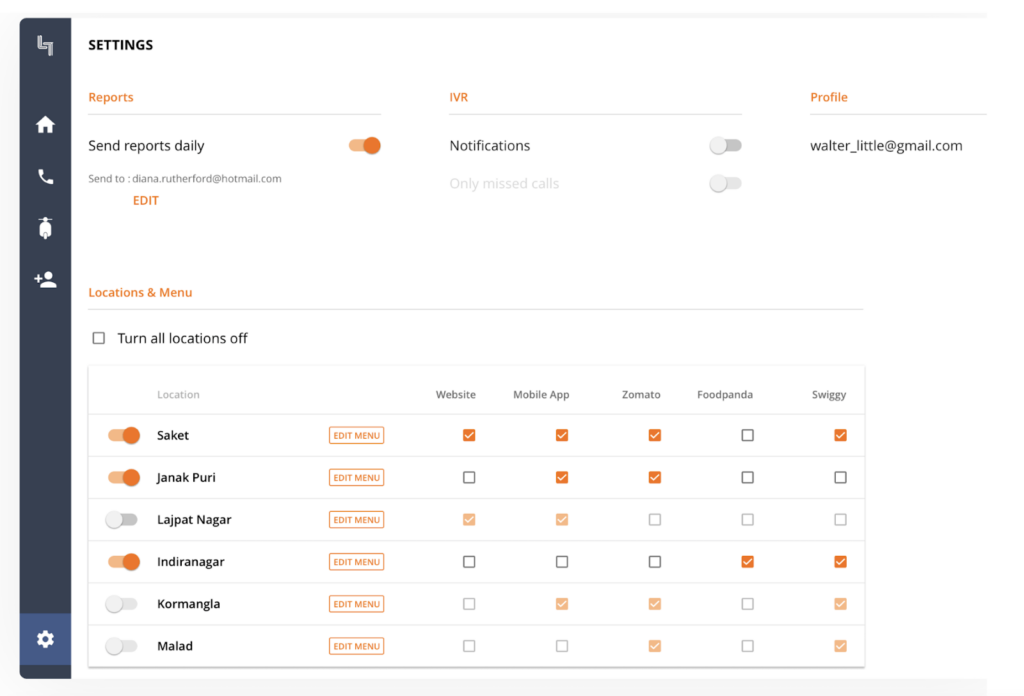
- Refined Marketing Strategies
Marketing is key to staying ahead in the competitive restaurant industry, but how do you know what works? Here’s where restaurant analytics and POS software come into play. With insights into customer preferences and seasonal trends, you can predict demand and adjust your marketing tactics accordingly.
Beyond marketing, restaurant POS analytics also helps optimize staffing by predicting peak hours. By analyzing sales data, you can promote top-selling dishes and eliminate underperforming items, ensuring personalized campaigns that drive results.
This data-driven approach helps track ROI and focus on strategies that boost customer loyalty.
- Track Financial Health
Managing your restaurant’s finances doesn’t have to be overwhelming. A certified POS system gives you easy access to detailed financial reports, from daily revenue to expenses and profits, making tax compliance and audits simpler.
Regular analysis helps you spot trends, track spending, and adjust strategies to improve profitability. With the right system, you gain a clear picture of your financial health.
In line with this, LimeTray’s analytics tool can give you access to dashboards to monitor performance anytime and anywhere. Even if you’re using iOS or Android, LimeTray ensures you’re always connected to your restaurant’s performance, empowering you to make informed decisions, even on the move.

- Integration with Third-Party Platforms
Restaurant POS analytics eliminates the hassle of overseeing multiple aggregator dashboards, consolidating all data into one cohesive platform for better decision-making.
Plus, with LimeTray’s integration capabilities, managing online orders has never been easier. By connecting with platforms like Swiggy, Zomato, and Uber Eats, you can access detailed analytics for every order, as depicted in the snapshot below.
You can also view peak ordering times, popular dishes, and delivery performance to optimize your strategy.
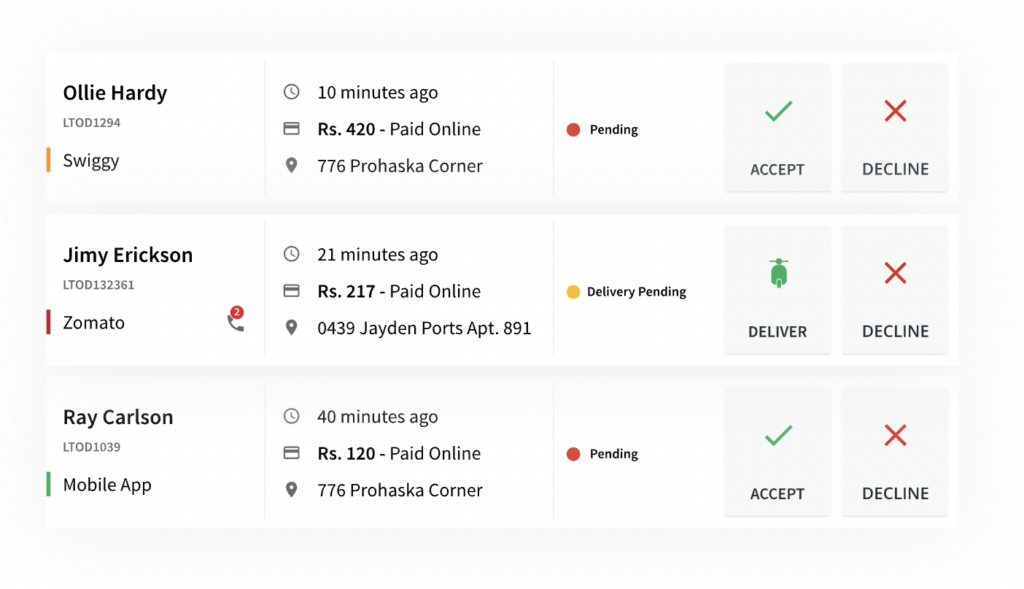
- Improved Customer Experience
Customer satisfaction is at the heart of every restaurant’s success. With restaurant POS analytics, you can get deeper insights into customer behavior and feedback. By tracking things like order preferences, feedback, and loyalty patterns, you can create a more personalized experience for each guest.
The best part? You don’t need to be a data expert—just integrate the right tools and see immediate results.
Discover how Paratha King increased direct orders and customer loyalty with LimeTray’s POS system. Read here!
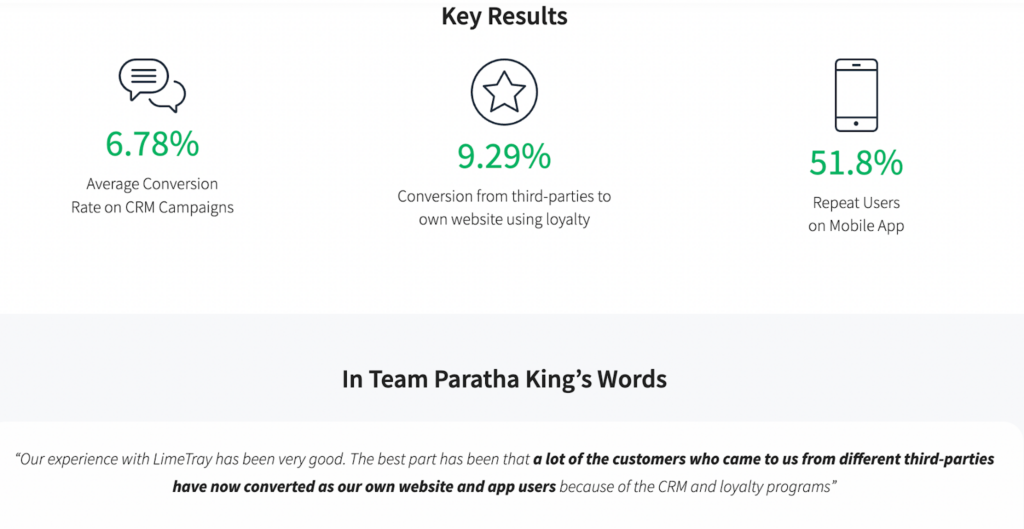
Now that you know how restaurant analytics and POS software can develop your operations, it’s time to take a closer look at the key reports and metrics that can guide your decisions and drive your restaurant’s success.
10 Reports and Metrics of Restaurant Analytics
Running a restaurant is like conducting a symphony, with each task playing a different note. Keeping everything in harmony can feel like managing a dozen instruments at once. But here’s the good news: restaurant POS analytics can help you automate operations and make data-driven decisions.
Let’s take a look at some of the key metrics and reports you can track with restaurant POS analytics.
- Cost of Goods Sold (COGS)
Ever wonder if your menu items are truly profitable? COGS reports can help you answer that. These reports track how much you’re spending on ingredients and compare it to your sales. By analyzing COGS, you can identify which dishes are bringing in the most profit and which ones are draining your resources.
- COGS by Item: This breaks down the cost of each dish and compares it to the revenue it generates.
- Overall COGS: Gives you a clear picture of the total cost to produce your menu items.
By keeping an eye on these numbers, you can adjust pricing, reduce waste, and improve profitability. A good restaurant POS system with advanced analytics can make all of this easy to track and manage.
- Inventory Reports
Running out of ingredients at the wrong time or overstocking items that end up going to waste is more common than you think. Effective inventory management and restaurant analytics can make it much easier.
By analyzing past sales trends and ingredient usage, POS data can help you predict what you need to keep on hand. With live stock-tracking, you can keep tabs on stock levels, avoid waste, and stay on top of demand.
- Stock Levels: Get live updates on inventory quantities.
- Inventory Turnover: Tracks how quickly your stock is being used.
- Waste & Shrinkage: Pinpoint areas where food is getting wasted or lost.
Stay ahead of customer demand with LimeTray’s restaurant POS, featuring automated inventory management. Get inventory reports that ensure you’re always stocked and prepared, as highlighted in the image below.
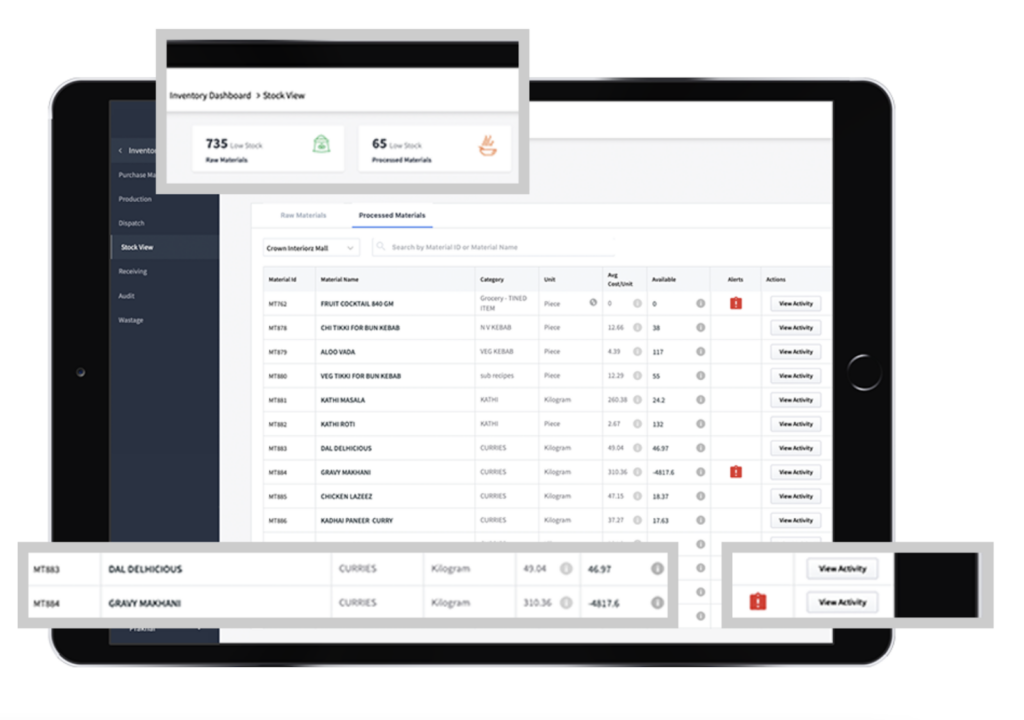
- Labor Reports
Staffing can be a tricky balancing act. Overstaffing eats into your profits, while understaffing can lead to poor service. The good part is that restaurant POS analytics can help optimize your staffing levels.
By tracking peak hours, customer traffic patterns, and sales data, you can adjust your schedules to make sure you always have the right number of staff on hand. For example, POS analytics also track individual performance metrics such as the following.
- Shift Schedules: Manage staff shifts efficiently and ensure optimal coverage during peak hours to maintain smooth operations.
- Tips and Sales: Track tips alongside sales data to get a comprehensive view of employee performance and revenue generation.
- Waiting Times: Monitor customer wait times to identify bottlenecks and improve service speed, enhancing customer satisfaction.
This data helps you assess employee performance and identify areas for improvement. Using these insights, you can create efficient schedules, reward top performers, and improve overall productivity.
- Sales Reports
Are your sales numbers what you expected? Sales reports break down revenue by time, day, and even by menu items, giving you a clear picture of what’s selling well and what isn’t. This data can help you adjust menu offerings, optimize pricing, and plan promotions more effectively.
- Daily Sales: Track sales trends by day and hour.
- Menu Item Performance: Identify bestsellers and slow movers.
- Discounts and Promotions: See how well your promotions are performing.
With restaurant POS analytics, you can track all of this and make smarter, data-driven decisions that boost sales.
- Customer Reports
Customer feedback is crucial for improving service quality and customer experience. Many restaurant POS systems now allow for integrated feedback collection, such as surveys or customer ratings.
For instance, if a dish is consistently receiving poor reviews, you can act quickly to improve it, or if certain staff members are consistently praised, you can recognize and reward them. Tracking customer sentiment allows restaurants to make adjustments faster and keep visitors happy.
A customer report’s key metrics include the following.
- Customer Loyalty: Tracks repeat customers and their order history.
- Customer Demographics: Identifies age, gender, location, and spending behavior of your customers.
- Customer Satisfaction: Analyzes feedback from reviews and surveys to gauge customer happiness.
Looking to level up your customer experience? With LimeTray’s feedback system, you can gather valuable insights like favorite dishes, ordering frequency, and more. Collect feedback directly at the point of sale, allowing you to resolve concerns on the spot, improve service quality, and fine-tune your menu based on real-time customer input.
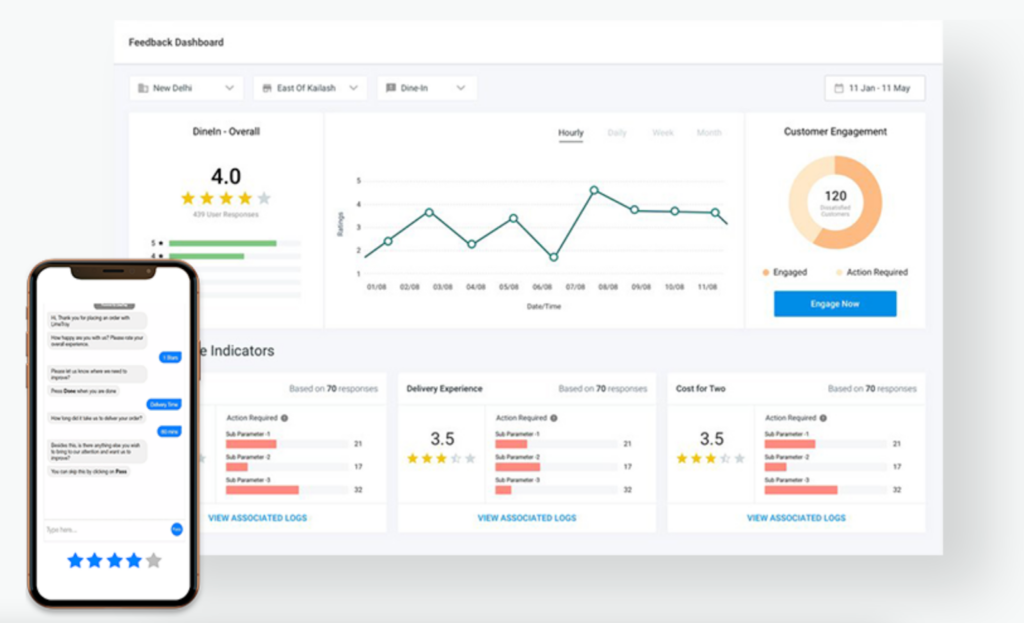
- Menu Performance Reports
Not all menu items are created equal. Some are winners, while others might be dragging down your profit margins. Menu engineering reports analyze each item’s profitability and popularity.
POS analytics offer key insights into your menu’s performance, helping identify top-sellers and underperformers. By analyzing sales, ingredient costs, and customer preferences, you can optimize pricing and refine your menu to boost profitability.
Additionally, combining this data with customer feedback and seasonal trends helps with inventory management and promotions, ensuring your menu aligns with demand and drives sales.
Menu performance reports provide insights into which items are popular with customers and which aren’t.
- Top-Selling Items: Lists your most popular dishes by revenue.
- Underperforming Items: Identifies menu items that aren’t generating much revenue or have low customer demand.
- Profitability by Item: Helps assess which menu items are the most profitable based on food cost and selling price.
- Table Turnover Reports
Table turnover is a critical metric in understanding how efficiently you’re utilizing your dining area. Using POS analytics, you can track this data live, which allows you to make adjustments and enhance the overall dining experience for both staff and customers.
This report tracks the following data.
- Average Table Turn Time: Shows how long customers are staying at each table.
- Table Occupancy Rates: Tracks how often tables are occupied during service hours.
- Revenue Per Table: Measures the revenue generated by each table throughout the service.
- Promotions and Discount Reports
Promotions and discount reports provide valuable insights into the performance of your special offers, helping you understand which promotions drive the most sales. By tracking the uptake and success of discounts, you can fine-tune future offers to maximize your restaurant’s profitability.
For example, a popular Italian restaurant used POS analytics to track its “Buy One, Get One Free” pizza promotion and found it worked best mid-week when foot traffic was slower. This insight helped them adjust future offers and timing, ultimately boosting profitability.
- Discounts Applied: Shows the total value of discounts or promotions given.
- Effectiveness of Offers: Compares sales during promotions versus regular pricing.
- Customer Response to Discounts: Tracks how customers are responding to promotional campaigns.
This data enables smarter decisions on which promotions to run and when ensuring that your discounts are beneficial to your customers.
- Order Trends Reports
Keeping track of order trends is key for adjusting your menu and preparing for high-demand periods. Restaurant POS analytics can give you insights into which dishes are popular and which need a little more attention.
Order trends reports track the volume of orders over specific time frames, allowing you to identify trends and plan accordingly. The metrics included in these reports are as follows.
- Order Volume by Time of Day: Helps you understand peak hours for customer traffic.
- Order Volume by Day of Week: Identifies trends in sales based on different days.
- Order Volume by Customer Group: Shows if certain customer groups (e.g., regulars, first-time visitors) are ordering more.
This data helps you adjust your kitchen workflow and inventory to meet demand.
- Financial Reports
At the end of the day, it’s all about the profits. Financial reports provide an overview of your restaurant’s financial health, including income, expenses, and profits.
- Revenue: Track daily, weekly, and monthly income.
- Expenses: Monitor operational expenses, including labor, COGS, and overhead.
- Profit Margins: See how much profit you’re making after expenses.
With our restaurant POS analytics, you can generate detailed financial reports that help you understand where your money is going and where you can cut costs to improve profitability. See how this can help your business—read more here!
Conclusion
Incorporating restaurant POS analytics into your daily operations can completely revamp how your business runs. With access to these insights, you have the right tools to drive efficiency, enhance service quality, and ultimately expand your profit margins.
LimeTray’s restaurant POS solutions offer exactly what you need to harness the full potential of analytics, allowing you to adapt swiftly and fine-tune every aspect of your business. It’s no surprise that leading brands like Burger King India, Mad Over Donuts, and Jollibee Brunei trust LimeTray for their POS needs.
Why not join them and transform your business with top-notch restaurant POS analytics today?



